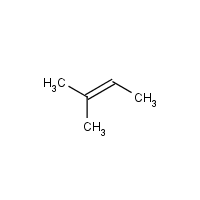Amylene
Agent Name
Amylene
Alternative Name
2-Methyl-2-butene
CAS Number
513-35-9
Formula
C5-H10
Major Category
Other Classes

Synonyms
1,1,2-Trimethylethylene; 2-Butene, 2-methyl-; 2-Methylbut-2-ene; 3-Methyl-2-butene; Amylene (VAN); Ethylene, trimethyl-; Trimethylethylene; beta-Isoamylene; [ChemIDplus] UN2460
Category
Aliphatics, Unsaturated
Description
Colorless volatile liquid with a disagreeable odor; [HSDB] Colorless liquid; bp 35-38 deg C; [MSDSonline]
Sources/Uses
Used as a chemical intermediate for isoprene and tertiary pentyl alcohol (pharmaceutical solvent); as an additive in high octane fuel manufacture; for hydrogenation, halogenation, alkylation, and condensation reactions; [HSDB] Used as an intermediate in the production of hydrocarbon resins, as a stabilizer for chloroform, and as a component of natural gas and crude oil; [eChemPortal: SIDSUNEP] Was used as an anesthetic in humans; [ACGIH]
Comments
Highly flammable liquid that is a simple asphyxiant; [Merck Index] May cause irritation or burns to skin and eyes; [CAMEO] Inhalation of high concentrations can cause CNS depression; A mild skin irritant; [eChemPortal: SIDSUNEP] Animal studies have shown chromosomal damage with inhalation exposures of 3000 ppm and greater. Chromosomal damage (clastogenic effects) is indicated by increases in micronucleated polychromatic erythrocytes in bone marrow. [ACGIH]
Biomedical References
Exposure Assessment
TLV (ACGIH)
10 ppm
Vapor Pressure
468 mm Hg
Lethal Concentration
LC50 (rat) > 61,000 PPM/4H
Explanatory Notes
Flash point = -17.8 deg C; [Merck Index] VP from ChemIDplus;
NFPA
may ignite at ambient temp
Adverse Effects
Neurotoxin
Acute solvent syndrome
Other Poison
Simple Asphyxiant
Diseases, Processes, and Activities Linked to This Agent
Diseases
Occupational diseases associated with exposure to this agent:
Processes
Industrial Processes with risk of exposure: